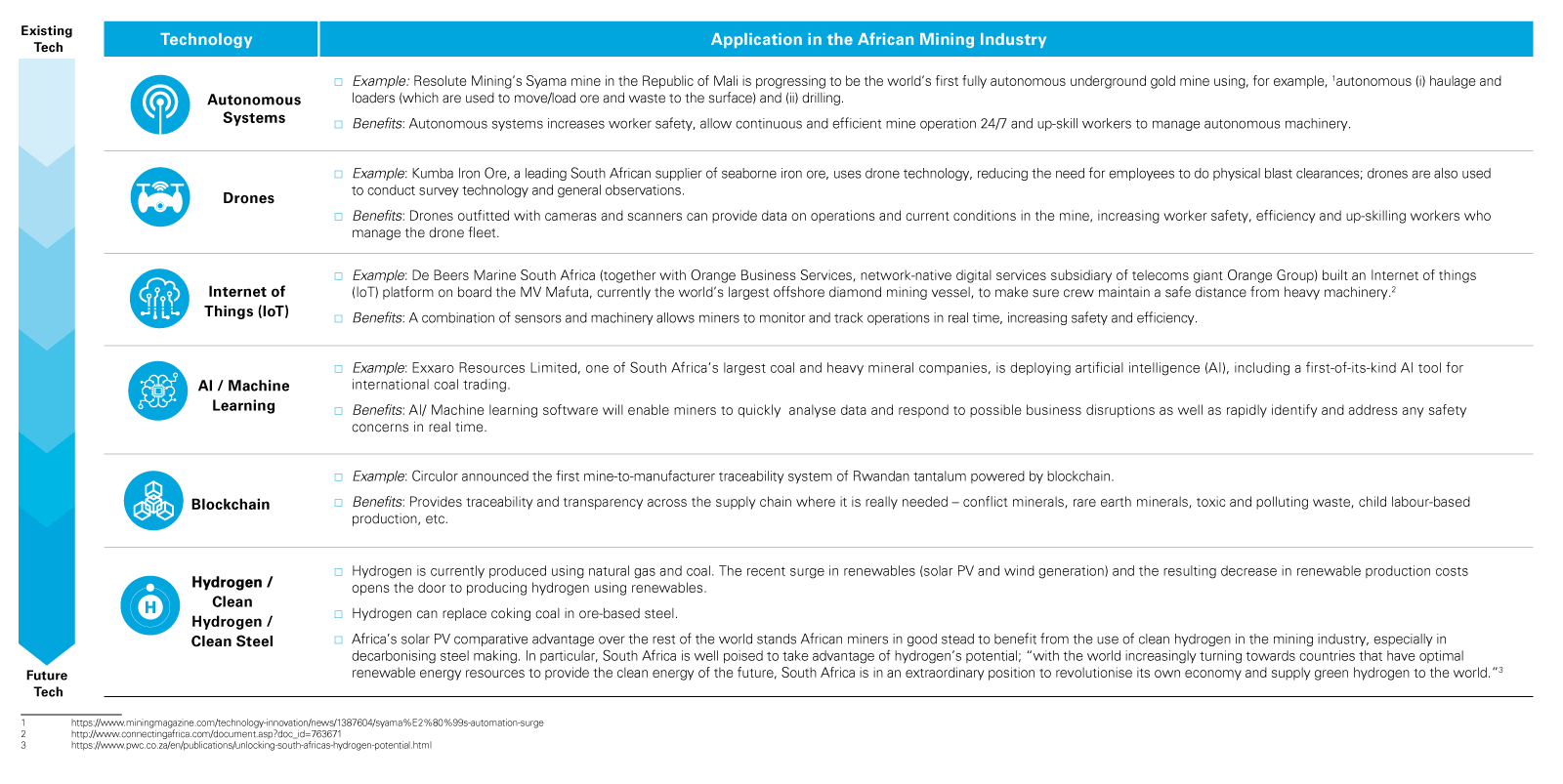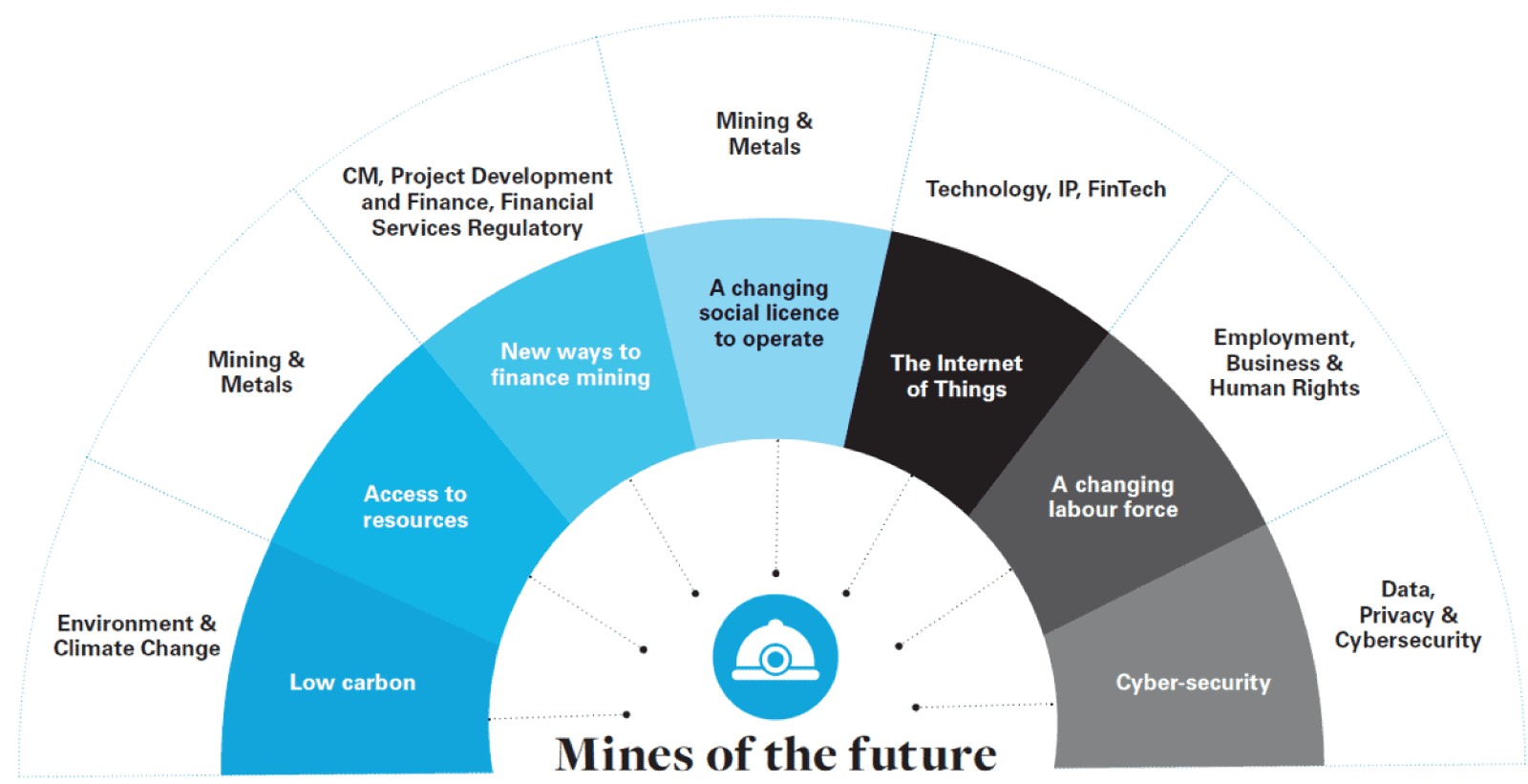
World in Transition
Our views on changing dynamics in energy, ESG, finance, globalization and US policy.
With the increasing pace of innovation, accelerated by COVID-19, new transformative mining technologies are rapidly becoming available to the mining industry, ushering in a new era of increased productivity, efficiency, safety and, growth, for miners.
African miners stand to gain as the world embraces a new digital revolution. New transformative mining technologies allow miners to mine resources that were previously unaffordable and impossible to access.
Transformative technologies will not only increase the bottom for African mining companies. Importantly, adoption of new technologies will facilitate better environment, social and governance (ESG) performance.
In this article, we survey the state of play in technology and equipment innovation in Africa and discuss the challenges and the opportunities facing African mining companies as they embrace new innovative technologies.
Mining Technologies
African mining companies are rapidly adopting the latest technologies to modernize their operations, yet significant opportunities remain. Set out below are some examples of existing and future mining technologies, and their application in the African mining industry.
Mining Technologies Driving ESG Compliance
Widespread adoption of the existing and emerging technologies shown above will allow African mining companies to not only take a huge leap forward technologically, but also address critical ESG matters by adhering to newly formed industry standards.
ESG has been a focal point for the mining industry. The International Council of Mining and Metals (ICMM) recently launched a set of Mining Principles intended to drive responsible production. The Mining Principles define best practice environmental, social and governance requirements for the industry through a comprehensive set of performance expectations. The requirements include, among other things, a focus on health and safety and environmental performance. New technologies can help address both but come with their own new challenges.
Health and Safety
On 1 Dec 2020, Ivanhoe Mines and Zijin announced the closing of an equipment financing facility for their Kamoa-Kakula Copper Project in the Democratic Republic of Congo. The Project's goal is to produce the world's "greenest copper"2 and monies from the facility will be used by the project to purchase automated underground mobile mining equipment and services.
Automated mobile mining equipment is the first step towards autonomous machinery that is operated remotely or semi-remotely, which in turn reduces the risks of injury to employees as they will not be directly at the mine face, thereby reducing human exposure to risks like rock-falls, earth tremors and other dangerous situations. Africa’s newest mines, like the Kamoa-Kakula Copper Project, are being designed for continuous progression towards autonomous mining over time, starting with automated equipment. Newer mining methodologies can also open new opportunities by making previously uneconomic deposits viable whilst vastly improving safety, as witnessed at another of Ivanhoe Mines' projects, the Platreef platinum mine, which relies on massive mining methods, in contrast to the narrow vein mining methods used by most other PGM miners in Africa.
Some argue that the usage of automated and autonomous machinery, however, may have collateral implications on jobs and surrounding communities around mine sites, which are reliant on the mines for employment. The mining industry, particularly in Africa, is traditionally very labour-intensive. Automated and autonomous mining methods require more highly skilled employees and ultimately less people at the mine face, but this does not necessarily lead to overall less employment in the vicinity of the mine after secondary employment is taken into account. The resultant transition of the labour force towards needs to be carefully managed with communities, governments, labour unions and employee representatives before new technologies are implemented. Where possible, employers need to investigate re-skilling and retraining of their employees to meet the changing skill-set required by introducing these technologies. Even though certain new jobs will be created (autonomous/remote-vehicle managers, etc.), if there isn't a managed process of transition in place, these changes may not be accepted by affected communities and host governments, and miners will struggle to maintain their social licence to operate.
Environmental efficiencies
Investors, customers, and host communities are increasingly scrutinizing the environmental and social impacts of mining operations. New technologies enable miners to reduce their carbon footprint, improve the efficiency in which they use non-renewable or scarce resources and minimise the amount and hazardousness of waste generated by such operations. From an energy perspective, mines are looking to implement renewable forms of energy generation that reduce greenhouse gases that are otherwise emitted from burning fossil fuels. These renewable energy sources become more attractive with significant advancements in battery storage technology providing power when the sun is not shining or the wind is not blowing.
The effects of climate change are predicted to cause droughts in many areas where mining activities are conducted. In these areas, technologies that allow mines to use water resources more sparingly and, where possible, re-use or recycle water will become essential for promoting the longevity and sustainability of the mining industry while building resilience to the effects of climate change.
With investors, funds and commercial banks all being more aware of ESG related risks and impacts, financing of mining operations and related expansions and extensions may become increasingly difficult because of internal policies and international regulations and policies such as the Equator Principles, IFC Standards and World Bank Guidelines. The mines of the future which incorporate cleaner and/or more efficient technologies will ultimately find it easier to secure funding. But there is a transition ongoing for funders as well – the "mines of the future" necessarily require funding of sometimes unproven technologies, which may in turn face challenges getting approved by investment and/or credit committees, especially amongst the more "traditional" funders to the sector.
Innovation, including through improvement of safety and environmental efficiencies (in line with ICMM’s Mining Principles) will allow African miners to build mines of the future that are not only sustainable but better capable of securing funding for expansions and additional innovative technologies.
Legal Considerations
Despite still lagging behind technological advancements, mining laws across Africa continue to evolve and so the miners that embrace and lead change will reap the early bird rewards. 'The mine of the future requires leadership that embraces a culture of data-led decision-making and a new way of thinking and operating.'3 While miners will encounter countless legal considerations, we set out a couple of key ones.
Permitting
Implementing new technologies has the opportunity for significant environmental and social improvements to mine efficiency and waste and emissions reductions. However, the implementation of new technologies at mines is often delayed due to lengthy administrative procedures. From a timing perspective, companies need to account for these significant delays in their construction and operational timelines. Given the significant positive impacts that may arise for both the mines, the environment and the surrounding communities, governments may wish to re-consider their regulatory processes to allow for streamlined permitting and amendment processes for "sustainable technology" options.
Carbon Credit Regulations
As miners improve their environmental efficiencies, they may be able to take advantage of carbon credit programmes. To the extent that alterations to existing projects or new projects meet the "additionality" requirements contemplated under the carbon credits programmes, it may be possible for mining companies to generate carbon credits to offset any excesses of their carbon budgets or carbon taxes.
Data Privacy and Intellectual Property
New technologies rely on data transfer, sometimes including personal data, from one party to another and at times, via a service provider's network. Miners will need to ensure any new technologies are implemented in accordance with applicable data protection laws to protect personal data to avoid hefty fines. In addition to the potential disclosures of protected and personal information if databases are breached, if third parties gain operational control of technology and machinery at mines, they could cause significant damage to the environment, health and safety, and mining operations.
Also, as miners incorporate third party technological advancements into their systems, they may find themselves innovating independently of third party technology and should have in place robust intellectual property management processes to protect their innovations as well as to protect against any inadvertent breaches of the intellectual property of third parties.
Final Thoughts
Embracing available and future technologies is significant to the resilience and sustainability of the African mining industry, enabling African miners to jump from Industry 2.0 to 4.0.
While the initial set up costs will be significant, the return on investment over time should create profitability, jobs4, and importantly, drive ESG performance.
An innovative sunrise for African miners is just around the corner. It looks green as well.
1 https://www.icmm.com/mining-principles
2 https://www.ivanhoemines.com/news/2020/kamoa-kakula-copper-project-secures-us-420-million-in-project-level-credit-facilities-including-a-eur-176-million-us-211/
3 Deloitte The Future of Mining in Africa 2018
4 https://www.miningreview.com/energy/africa-transformative-mining-technology/
This article was first published in African Mining.
This publication is provided for your convenience and does not constitute legal advice. This publication is protected by copyright.

 View full image: Technology - Application in the African Mining Industry (PDF)
View full image: Technology - Application in the African Mining Industry (PDF)
 View full image: Mines of the future (PDF)
View full image: Mines of the future (PDF)

